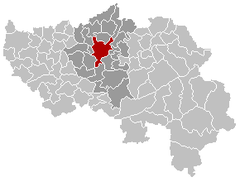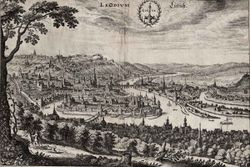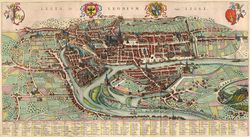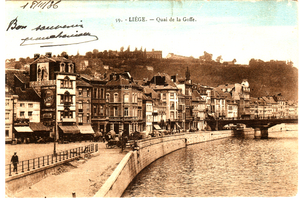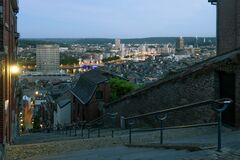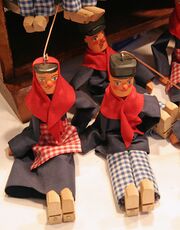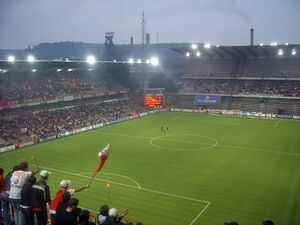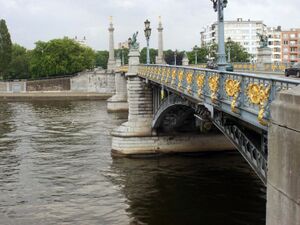لييج
لييج
Lîdje (والون) | |
|---|---|
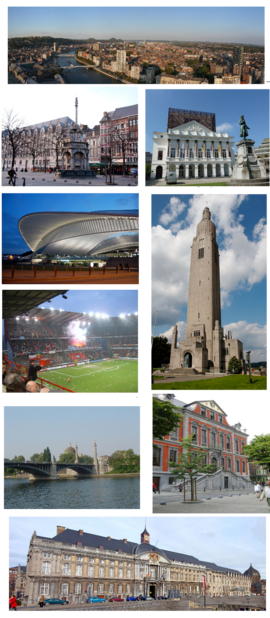 | |
| الإحداثيات: 50°38′N 05°34′E / 50.633°N 5.567°E | |
| البلد | بلجيكا |
| Community | French Community |
| المنطقة | والونيا |
| المقاطعة | Liège |
| Arrondissement | لييج |
| الحكومة | |
| • العمدة | Willy Demeyer (PS) |
| • الحزب الحاكم | PS – cdH |
| المساحة | |
| • الإجمالي | 69٫39 كم² (26٫79 ميل²) |
| التعداد (2018-01-01) | |
| • الإجمالي | 197٬355 |
| • الكثافة | 2٬800/km2 (7٬400/sq mi) |
| Postal codes | 4000–4032 |
| Area codes | 04 |
| الموقع الإلكتروني | www.liege.be |
لييج (فرنسية: Liège؛ النطق الفرنسي: [ljɛːʒ]؛ هولندية: Luik، [lœyk] (![]() استمع)؛ والون: Lidje؛ ألمانية: Lüttich؛ لاتينية: Leodium؛ Limburgish: Luuk؛ لوكسمبورگية: Léck؛ حتى 17 سبتمبر 1946[1][2][3] كان اسم المدينة مكتوباً Liége، بـacute accent بدلاً من grave accent)، هي مدينة رئيسية وبلدية بلجيكية تقع في مقاطعة لييج، التي هي عاصمتها الاقتصادية، في والونيا، المنطقة الناطقة بالفرنسية في بلجيكا.
استمع)؛ والون: Lidje؛ ألمانية: Lüttich؛ لاتينية: Leodium؛ Limburgish: Luuk؛ لوكسمبورگية: Léck؛ حتى 17 سبتمبر 1946[1][2][3] كان اسم المدينة مكتوباً Liége، بـacute accent بدلاً من grave accent)، هي مدينة رئيسية وبلدية بلجيكية تقع في مقاطعة لييج، التي هي عاصمتها الاقتصادية، في والونيا، المنطقة الناطقة بالفرنسية في بلجيكا.
تقع المدينة في وادي نهر موز، بالقرب من حدود بلجيكا الشرقية مع هولندا وألمانيا، حيث يلتقي نهر الموز مع اورث. وكانت لليج هي الوادي الصناعي والمركز الصناعي لوالونيا. بلدية لييج تضم البلدات السابقة التالية: Angleur, Bressoux, Chênée, Glain, Grivegnée, Jupille-sur-Meuse, Rocourt, وWandre.
المدينة هي المركز الاقتصادي والثقافي الرئيسي في والونيا. وفي أكتوبر 2011، بلغ تعداد لييج 196,496 نسمة. المساحة العمرانية، بما فيها منطقة المتنقلين يومياً، تغطي مساحة 1,879 كم2 وكان إجمالي عدد سكانها 749,110 في 1 يناير 2008.[4][5] وهذا يضم إجمالي 52 بلدية، منهم هرستال وسريانج. وتعتبر لييج ثالث الأكبر المناطق الحضرية من حيث عدد السكان في بلجيكا، بعد بروكسل وأنتويرپ، ورابع بلدية بعد أنتويرپ، غنت، وشارلروا.[5]
التاريخ
العصور الوسطى المبكرة
Although settlements already existed in Roman times, the first references to Liège are from 558, when it was known as Vicus Leudicus. Around 705, Saint Lambert of Maastricht is credited with completing the Christianization of the region, indicating that up to the early 8th century the religious practices of antiquity had survived in some form. Christian conversion may still not have been quite universal, since Lambert was murdered in Liège and thereafter regarded as a martyr for his faith. To enshrine St. Lambert's relics, his successor, Hubertus (later to become St. Hubert), built a basilica near the bishop's residence which became the true nucleus of the city.[بحاجة لمصدر]
A few centuries later, the city became the capital of a prince-bishopric, which lasted from 985 till 1794. The first prince-bishop, Notger, transformed the city into a major intellectual and ecclesiastical centre, which maintained its cultural importance during the Middle Ages. Pope Clement VI recruited several musicians from Liège to perform in the Papal court at Avignon, thereby sanctioning the practice of polyphony in the religious realm. The city was renowned for its many churches, the oldest of which, St Martin's, dates from 682. Although nominally part of the Holy Roman Empire, in practice it possessed a large degree of independence.[بحاجة لمصدر]
العصور الوسطى المتأخرة ومطلع العصر الحديث
The strategic position of Liège has made it a frequent target of armies and insurgencies over the centuries. It was fortified early on with a castle on the steep hill that overlooks the city's western side. During this medieval period, three women from the Liège region made significant contributions to Christian spirituality: Elizabeth Spaakbeek, Christina the Astonishing, and Marie of Oignies.[6]
In 1345, the citizens of Liège rebelled against Prince-Bishop Engelbert III de la Marck, their ruler at the time, and defeated him in battle near the city. Shortly after, a unique political system formed in Liège, whereby the city's 32 guilds shared sole political control of the municipal government. Each person on the register of each guild was eligible to participate, and each guild's voice was equal, making it the most democratic system that the Low Countries had ever known. The system spread to Utrecht, and left a democratic spirit in Liège that survived the Middle Ages.[7]
At the end of the Liège Wars, a rebellion took place against rule from Burgundy. In 1468 Duke Charles the Bold of Burgundy, witnessed by King Louis XI of France, captured and largely destroyed the city after a bitter siege which was ended with a successful surprise attack. The rebellion figures prominently in the plot of Sir Walter Scott's 1823 novel Quentin Durward.[بحاجة لمصدر]
The Prince-Bishopric of Liège was technically part of the Holy Roman Empire which, after 1477, came under the rule of the Habsburgs. The reign of prince-bishop Érard de La Marck (1506–1538) coincides with the dawn of the Renaissance.[بحاجة لمصدر]
During the Counter-Reformation, the diocese of Liège was split and progressively lost its role as a regional power. By the 17th century, the bishopric of Liège became a virtual Secundogeniture of the Bavarian royal house of Wittelsbach, with second sons of the Bavarian monarch ruling as prince-bishop. Beginning with the ascension of Ernest of Bavaria in 1581, Bavarian princes ruled over Cologne, Münster, and other bishoprics in the northwest of the Holy Roman Empire in addition to Liège. Ferdinand of Bavaria (bishop) ruled from 1612 to 1650, and Maximilian Henry of Bavaria ruled from 1650 to 1688.[بحاجة لمصدر]
In 1636, during the Thirty Years' War, the city was besieged by Imperial forces under Johann von Werth from April to July. The army, mainly consisting of mercenaries, extensively and viciously plundered the surrounding bishopric during the siege.[8]
القرن 18 إلى الحرب العالمية الأولى
The Duke of Marlborough captured the city from the Bavarian prince-bishop and his French allies in 1704 during the War of the Spanish Succession.
In the middle of the eighteenth century the ideas of the French Encyclopédistes began to gain popularity in the region. Bishop François-Charles de Velbrück (1772–84), encouraged their propagation, thus prepared the way for the Liège Revolution which started in the episcopal city on 18 August 1789 and led to the creation of the Republic of Liège before it was invaded by counter-revolutionary forces of the Habsburg monarchy in 1791.
In the course of the 1794 campaigns of the French Revolution, the French Revolutionary Army took the city and imposed strongly anticlerical regime, destroying St. Lambert's Cathedral. The overthrow of the Prince-Bishopric of Liège was confirmed in 1801 by the Concordat co-signed by Napoléon Bonaparte and Pope Pius VII. France lost the city in 1815 when the Congress of Vienna awarded it to the United Kingdom of the Netherlands. Dutch rule lasted only until 1830, when the Belgian Revolution led to the establishment of an independent, Catholic and neutral Belgium which incorporated Liège. After this, Liège developed rapidly into a major industrial city which became one of continental Europe's first large-scale steel making centres. The Walloon Jacquerie of 1886 saw a large-scale working class revolt.[9] No less than 6,000 regular troops were called into the city to quell the unrest,[10] while strike spread through the whole sillon industriel.
Liège's fortifications were redesigned by Henri Alexis Brialmont in the 1880s and a chain of twelve forts was constructed around the city to provide defence in depth. This presented a major obstacle to the Imperial German Army in 1914, whose Schlieffen Plan relied on being able to quickly pass through the Meuse valley and the Ardennes en route to France. The German invasion of Belgium on 5 August 1914 soon reached Liège, which was defended by 30,000 troops under General Gérard Leman in the Battle of Liège. The forts initially held off General Alexander von Kluck's German First Army of about 100,000 men but were pulverised into submission by a five-day bombardment by heavy artillery, including thirty-two 21 cm mortars and two German 42 cm Big Bertha howitzers.[11][12] Due to faulty planning of the protection of the underground defence tunnels beneath the main citadel, one direct artillery hit caused a huge explosion, which eventually led to the surrender of the Belgian forces. The Belgian resistance was shorter than had been intended, but the twelve days of delay caused by the siege nonetheless contributed to the eventual failure of the German invasion of France. The city was subsequently occupied by the Germans until the end of the war. Liège received the Légion d'Honneur for its resistance in 1914.
As part of Chancellor Theobald von Bethmann Hollweg's Septemberprogramm, Berlin planned to annexe Liege under the name Lüttich to the German Empire in any post-war peace agreement.[13]
الحرب العالمية الثانية إلى الحاضر
The Germans returned in 1940, this time taking the forts in only three days. Most Jews were saved, with the help of the sympathetic population, as many Jewish children and refugees were hidden in the numerous monasteries. Liege was liberated by the British Second Army in September 1944.[14]
After the war ended, the Royal Question came to the fore, since many saw King Leopold III as collaborating with the Germans during the war. In July 1950, André Renard, leader of the Liègian FGTB launched the General strike against Leopold III of Belgium and "seized control over the city of Liège".[15] The strike ultimately led to Leopold's abdication.
Liège began to suffer from a relative decline of its industry, particularly the coal industry, and later the steel industry, producing high levels of unemployment and stoking social tension. During the 1960-1961 Winter General Strike, disgruntled workers went on a rampage and severely damaged the central railway station Guillemins. The unrest was so intense that "army troops had to wade through caltrops, trees, concrete blocks, car and crane wrecks to advance. Streets were dug up. Liège saw the worst fighting on 6 January 1961. In all, 75 people were injured during seven hours of street battles."[16]
On 6 December 1985, the city's courthouse was heavily damaged and one person was killed in a bomb attack by a lawyer.
Liège is also known as a traditionally socialist city. In 1991, powerful Socialist André Cools, a former Deputy Prime Minister, was gunned down in front of his girlfriend's apartment. Many suspected that the assassination was related to a corruption scandal which swept the Socialist Party, and the Belgian Federal Government in general, after Cools' death. Two men were sentenced to twenty years in jail in 2004, for involvement in Cools' murder.
Liège has shown some signs of economic recovery in recent years with the opening up of borders within the European Union, surging steel prices, and improved administration.[بحاجة لمصدر] Several new shopping centres have been built, and numerous repairs carried out.[بحاجة لمصدر]
On 13 December 2011, there was a grenade and gun attack at Place Saint-Lambert. An attacker, later identified as Nordine Amrani, aged 33, armed with grenades and an assault rifle, attacked people waiting at a bus stop. There were six fatalities, including the attacker (who shot himself), and 123 people were injured.[17]
On 29 May 2018, two female police officers and one civilian—a 22-year-old man—were shot dead by a gunman near a café on Boulevard d'Avroy in central Liège. The attacker then began firing at the officers in an attempt to escape, injuring a number of them "around their legs", before he was shot dead. Belgian broadcaster RTBF said the gunman was temporarily released from prison on 28 May where he had been serving time on drug offences. The incident is currently being treated as terrorism.[18]
الطقس
In spite of its inland position Liège has a maritime climate influenced by the mildening sea winds originating from the Gulf Stream, travelling over Belgium's interior. As a result, Liège has very mild winters for its latitude and inland position, especially compared to areas in the Russian Far East and the fellow Francophone province of Quebec. Summers are also moderated by the maritime air, with average temperatures being similar to areas as far north as in Scandinavia. Being inland though, Liège has a relatively low winter seasonal lag.
| Climate data for لييج | |||||||||||||
|---|---|---|---|---|---|---|---|---|---|---|---|---|---|
| Month | Jan | Feb | Mar | Apr | May | Jun | Jul | Aug | Sep | Oct | Nov | Dec | Year |
| Mean daily maximum °C (°F) | 3 (38) |
6 (42) |
9 (48) |
14 (57) |
18 (64) |
21 (69) |
22 (71) |
22 (71) |
19 (66) |
13 (55) |
9 (48) |
5 (41) |
13 (56) |
| Mean daily minimum °C (°F) | −2 (29) |
−1 (31) |
2 (35) |
5 (41) |
8 (47) |
12 (53) |
13 (56) |
13 (56) |
11 (51) |
7 (44) |
3 (38) |
1 (33) |
6 (43) |
| Average precipitation mm (inches) | 36 (1.4) |
41 (1.6) |
46 (1.8) |
36 (1.4) |
41 (1.6) |
66 (2.6) |
74 (2.9) |
64 (2.5) |
61 (2.4) |
64 (2.5) |
43 (1.7) |
58 (2.3) |
630 (24.7) |
| Source: Weatherbase [19] | |||||||||||||
السكان
في 1 يناير 2013، كانت بلدية لليج تضم 197,013 نسمة.[4] يسكن المنطقة الحضرية حوالي 750,000 نسمة. يتحدث سكانها في الغالب [الفرنسية، ويتحدث أقلية بالألمانية والهولندية. Akin to the rest of Belgium, the population of minorities has grown significantly since the 1990s.[20] The city has become the home to large numbers of Algerian, Moroccan, Turkish, and Vietnamese immigrants. Liège also houses a significant Afro-Belgian community.[21]
والمدينة مركز تعليمي رئيسي في بلجيكا. يوجد بها 42.000 طالب يدرسون في أكثر من 24 مدرسة. ويوجد بها جامعة لييج، تأسست 1817، وتضم 20.000 طالب.
| Group of origin | Year | |
|---|---|---|
| 2023[22] | ||
| Number | % | |
| Belgians with Belgian background | 85,622 | 43.83% |
| Belgians with foreign background | 70,590 | 36.14% |
| Neighboring country | 4,999 | 2.56% |
| EU27 (excluding neighboring country) | 19,077 | 9.77% |
| Outside EU 27 | 46,514 | 23.81% |
| Non-Belgians | 39,134 | 20.03% |
| Neighboring country | 5,077 | 2.6% |
| EU27 (excluding neighboring country) | 11,089 | 5.68% |
| Outside EU 27 | 22,968 | 11.76% |
| Total | 195,346 | 100% |
أهم المعالم

- The vast palace of the Prince-Bishops of Liège is built on the Place St Lambert, where the old St. Lambert's Cathedral used to stand before the French Revolution. The oldest rooms date from the 16th century. An archeological display, the Archéoforum, can be visited under the Place St Lambert.
- The perron on the nearby Place du Marché was once the symbol of justice in the Prince-Bishopric and is now the symbol of the city. It stands in front of the 17th century city hall.
- The seven collegiate churches of Liège:
- St Paul (raised to cathedral status as Liège Cathedral in 1802, after the demolition of St Lambert's Cathedral), It contains a treasury and Saint Lambert's tomb.
- St James (raised to collegiate status after the demolition of St Peter's Collegiate Church in 1811). Built in the flamboyant gothic style, with an early Renaissance porch. The statues are by Liège sculptor Jean Del Cour. Saint-Jacques contains 29 14th-century misericords.
- St Martin
- St Denis
- St John the Evangelist
- Holy Cross
- St Bartholomew
- The main museums in Liège are:
- La Boverie (Musée des Beaux-Arts)
- Museum of Walloon Life
- Museum of Walloon Art & Religious Art (Mosan art)
- The Grand Curtius Museum is an elegantly furnished mansion from the 17th century along the river Meuse, housing collections of Egyptology, weaponry, archaeology, fine arts, religious art and Mosan art.
- Other sites of interest include the historical city centre (the Carré), the Hors-Château area, the Outremeuse area, the parks and boulevards along the river Meuse, the Citadel, the 374[23] steps stairway "Montagne de Bueren", leading from Hors-Château to the Citadel, 'Médiacité' shopping mall designed by Ron Arad Architects, the Interallied Memorial of Cointe, a complex consisting of the Sacré-Cœur church and the Art Deco Memorial tower, designed by Joseph Smolderen, with a very nice view of the city and the Liège-Guillemins railway station designed by Santiago Calatrava.
- Liège's pedestrian zone is the biggest pedestrian zone of the Walloon Region and the Meuse-Rhine Euroregion;[24] it is also the oldest in Belgium. The pedestrian zone progressively has grown since 1965 to contain the majority of the hypercentre of Liège. It continues to grow today with the addition of the Rue de la Casquette on 12 December 2014.[25]
الفولكلور
The "Le Quinze Août" celebration takes place annually on 15 August in Outremeuse and celebrates the Virgin Mary. It is one of the biggest folkloric displays in the city, with a religious procession, a flea market, dances, concerts, and a series of popular games. Nowadays these celebrations start a few days earlier and last until the 16th. Some citizens open their doors to party goers, and serve "peket", the traditional local alcohol. This tradition is linked to the important folkloric character Tchantchès (Walloon for François), a hard-headed but resourceful Walloon boy who lived during Charlemagne's times. Tchantchès is remembered with a statue, a museum, and a number of puppets found all over the city.[بحاجة لمصدر]
Liège hosts one of the oldest and biggest Christmas Markets in Belgium, and the oldest kermesse, the Foire de Liège held each year from 28 October.[بحاجة لمصدر]
الثقافة
The city is well known for its very crowded folk festivals. The 15 August festival ("Le 15 août") may be the best known. The population gathers in a quarter named Outre-Meuse with plenty of tiny pedestrian streets and old yards. Many people come to see the procession but also to drink alcohol (mostly peket) and beer, eat cooked pears, boûkètes or sausages or simply enjoy the atmosphere until the early hours.[26] The Saint Nicholas festival around 6 December is organized by and for the students of the University; for a few days before the event, students (wearing very dirty lab-coats) beg for money, mostly for drinking.[27][28][29]
Liège is renowned for its nightlife.[30] Within the pedestrian zone behind the Opera House, there is a square city block known locally as Le Carré (the Square) with many lively pubs which are reputed to remain open until the last customer leaves (typically around 6 am). Another active area is the Place du Marché.
The "Batte" market is where most locals visit on Sundays.[بحاجة لمصدر] The outdoor market goes along the river Meuse and also attracts many visitors to Liège. The market typically runs from early morning to 2 o'clock in the afternoon every Sunday year long. Produce, clothing, and snack vendors are the main concentration of the market.
Liège is home to the Opéra Royal de Wallonie (إنگليزية: Royal Opera of Wallonia) and the Orchestre Philharmonique Royal de Liège (OPRL) (إنگليزية: Liège Royal Philharmonic Orchestra).
The city annually hosts a significant electro-rock festival Les Ardentes and jazz festival Jazz à Liège.
Liège has active alternative cinemas, Le Churchill, Le Parc and Le Sauvenière. There are also two mainstream cinemas, the Kinepolis multiplexes.
Liège also has a particular Walloon dialect, sometimes said to be one of Belgium's most distinctive. There is a large Italian community, and Italian can be heard in many places.
الرياضة
The city has a number of football teams, most notably Standard Liège, who have won several championships and which was previously owned by Roland Duchâtelet, and R.F.C. de Liège, one of the oldest football clubs in Belgium. It is also known for being the club who refused to release Jean-Marc Bosman, a case which led to the Bosman ruling.
In spring, Liège hosts the start and finish of the annual Liège–Bastogne–Liège cycling race, one of the spring classics and the oldest of the five monuments of cycling. The race starts in the centre of Liège, before heading south to Bastogne and returning north to finish in the industrial suburb of Ans. Traveling through the hilly Ardennes, it is one of the longest and most arduous races of the season.[31]
Liège is the only city that has hosted stages of all three cycling Grand Tours. It staged the start of the 1973 and 2006 Giro d'Italia; as well as the Grand Départ of the 2004, 2012,[32][33][34] and 2017[35] Tour de France making it the first city outside France to host the Grand Départ twice or more times.[36] In 2009, the Vuelta a España visited Liège after four stages in the Netherlands, making Liège the first city that has hosted stages of all three cycling Grand Tours.[37]
Liège is also home to boxer Ermano Fegatilli, the current European Boxing Union Super Featherweight champion.[38]
الاقتصاد
Liège is the most important city of the Walloon region from an economic perspective. In the past, Liège was one of the most important industrial centres in Europe, particularly in steel-making. Starting in 1817, John Cockerill extensively developed the iron and steel industry. The industrial complex of Seraing was the largest in the world. It once boasted numerous blast furnaces and mills. Liège has also been an important centre for gunsmithing since the Middle Ages and the arms industry is still strong today, with the headquarters of FN Herstal and CMI Defence being located in Liège. Although from 1960 on the secondary sector is going down and now is a mere shadow of its former self, the manufacture of steel goods remain important.
The economy of the region is now diversified; the most important centres are: Mechanical industries (Aircraft engine and Spacecraft propulsion), space technology, information technology, biotechnology and the production of water, beer or chocolate. Liège has an important group of headquarters dedicated to high-technology, such as Techspace Aero, which manufactures pieces for the Airbus A380 or the rocket Ariane 5. Other stand-out sectors include Amós which manufactures optical components for telescopes and Drytec, which produces compressed air dryers. Liège also has many other electronic companies such as SAP, EVS, Gillam, AnB, Balteau, IP Trade. Other prominent businesses are the global leader in light armament FN Herstal, the beer company Jupiler, the chocolate company Galler, and the water and soda companies Spa and Chaudfontaine. A science park south east of the city, near the University of Liège campus, houses spin-offs and high technology businesses.
1812 mine accident
In 1812 there were three coal pits (Bure) in close proximity just outside the city gates: Bure Triquenotte, Bure de Beaujone and Bure Mamonster. The first two shafts were joined underground, but the last one was a separate colliery. The shafts were 120 fathoms (720 ft; 220 m) deep. Water was led to a sump (serrement) from which it could be pumped to the surface. At 11:00 on 28 February 1812 the sump in the Beaujone mine failed and flooded the entire colliery. Of the 127 men down the mine at the time 35 escaped by the main shaft, but 74 were trapped. [These numbers are taken from the report, the 18 miner discrepancy is unexplained.] The trapped men attempted to dig a passageway into Mamonster. After 23 feet (7.0 m) there was a firedamp explosion and they realised that they had penetrated some old workings belonging to an abandoned mine, Martin Wery. The overseer, Monsieur Goffin, led the men to the point in Martin Wery which he judged closest to Mamonster and they commence to dig. By the second day they had run out of candles and dug the remainder of a 36 feet (11 m) gallery in darkness.
On the surface the only possible rescue was held to be via Mamonster. A heading was driven towards Beaujone with all possible speed, including blasting. The trapped miners heard the rescuers and vice versa. Five days after the accident communication was possible and the rescuers worked in darkness to avoid the risk of a firedamp explosion. By 7pm that evening an opening was made, 511 feet (156 m) of tunnel had been dug by hand in five days. All of the 74 miners in Goffin's part survived and were brought to the surface.[40]
Transport
Air
Liège is served by Liège Airport, located in Bierset, a few kilometres west of the city. It is the principal axis for the delivery of freight and in 2011 was the world's 33rd busiest cargo airport.[41] Passenger services are very few. It is owned by the Walloon government along with some private investors.
Maritime
The Port of Liège, located on the river Meuse, is the 3rd largest river port in Europe. Liège also has direct links to Antwerp through the Albert Canal and to Rotterdam via the river Meuse. It stretches over a distance of 26 kilometres and comprises 32 port areas and covers 3.7 square kilometres.
السكك الحديدية
Liège is served by many direct rail links with the rest of Western Europe. Its three principal stations are Liège-Guillemins railway station, Liège-Carré, and Liège-Saint-Lambert. The InterCity Express and Thalys call at Liège-Guillemins, providing direct connections to Cologne and Frankfurt and Paris-Nord respectively.
Liège was once home to a network of trams. However, they were removed by 1967 in favour of the construction of a new metro system. A prototype of the metro was built and a tunnel was dug underneath the city, but the metro was never built. The construction of a new modern tramway has been ordered and was once scheduled to open by 2017; however the first rails were only laid in April 2021.[42]
الطرق
Liège sits at the crossroads of a number of highways including the European route E25, the European Route E42, the European Route E40 and the European Route E313.
مشاهير السكان
- Pippin the Younger (بالفرنسية: Pépin le Bref)، ملك الفرنجة (ولد في جوپيل، القرن 8)
- Charlemagne, ملك فرانكس، ثم الامبراطور المتوج (ميلاده في القرن الثامن في لييج، غير مؤكد)
- Alger of Liège, تعلم ككاهن (القرن 11)
- William of St-Thierry, عالم لاهوت (القرن 11)
- Johannes Ciconia (القرن 14), composer, Master of the Ars Nova
- Jean d'Outremeuse, writer and historian (القرن 14)
- Jacques Arcadelt, مؤلف موسيقي، (القرن 16)
- Hubert Naich، مؤلف موسيقي، (القرن 16)
- Lambert Lombard، رسام (1505–1566)
- Theodor de Bry, engraver (1528–1598)
- Louis De Geer Introducer of Walloon Blast furnaces in Sweden (1587–1652]
- Linus of Liège (1595–1675) Counter-reformation critic of Isaac Newton
- Gérard de Lairesse, painter (1640–1711)
- André Ernest Modeste Grétry, composer (1741–1813)
- Hubert Joseph Walther Frère-Orban, statesman (1812–1896)
- César Franck, composer (1822–1890)
- Zénobe Gramme, inventor (1826–1901)
- José Dupuis, creator of many roles in Offenbach's opéras-bouffes (1833–1900)
- Georges Nagelmackers founder of the Compagnie Internationale des Wagons-Lits (1845–1905)
- Eugène Ysaÿe, composer and violinist (1858–1931)
- Emile Digneffe, lawyer and politician (1858–1937)
- Gustave Serrurier-Bovy Architect and furniture designer (1858–1910)
- Charles Magnette, lawyer and politician (1863–1937)
- Richard Heintz, Post-Impressionist painter (1871–1929)
- Louis Dewis, Post-Impressionist painter (1872–1946)
- Joseph Jongen, organist, composer, and educator (1873–1953)
- Marie Delcourt, Professor at the University, expert of the ancient Greek religion, Walloon movement activist (1891–1979)
- Jean Rey Old Minister, Walloon movement activist second President of the European Commission (1902–1983)
- Georges Simenon, novelist (1903–1989)
- Stanislas-André Steeman, writer (1908–1970)
- Henri Pousseur composer (1929–2009)
- Violetta Villas, polish singer and actress (1938–2011)
- Jean-Maurice Dehousse Politician, Walloon movement activists, first Minister-President of the Walloon Region
- Gary Hartstein, M.D. Formula 1 (born 1955)
- Groupe µ, team of scientists.
- Nicolas Ancion, writer (born 1971)
- Sandra Kim, winner of the 1986 Eurovision Song Contest for Belgium (born 1972)
- Philippe Léonard, football player (born 1974)
- Marie Gillain, International actress (born 1975)
- Justine Henin, top ranked female tennis player (born 1982)
- Axel Hervelle, basketball player (born 1983)
- Ermano Fegatilli, boxer (born 1984)
- Nacer Chadli, football player (born 1989)
- Axel Witsel, football player (born 1989)
- Julien Shaft and Ingrid Frost, fictional characters in the RTBF television show Frost & Shaft, which is set in Liège
العلاقات الدولية
المدن الشقيقة
لييج، على توأمة مع:
طالع أيضاً
- جامعة لييج
- منتزه العلوم في لييج
- إمارة-أسقفية لييج
- Liège–Bastogne–Liège
- Ratherius
- جزيرة لييج، أنتارتيكا، سميت على اسم المدينة
المراجع
- الهامش
- ^ The Book Collector. Vol. 8 (1959), p. 10.
- ^ Room, Adrian. 2006. Placenames of the World. 2nd ed. Jefferson, NC: McFarland & Co., p. 219.
- ^ "Liège". 1991. Encyclopaedia Britannica: Micropædia. Vol. 7. Chicago: Encyclopaedia Britannica, p. 344.
- ^ أ ب Statistics Belgium; Population de droit par commune au 1 janvier 2008 (excel-file) Population of all municipalities in Belgium, as of 1 January 2008. Retrieved on 2008-10-19.
- ^ أ ب Statistics Belgium; De Belgische Stadsgewesten 2001 (pdf-file) Definitions of metropolitan areas in Belgium. تنقسم المنطقة الحضرية في لييج إلى ثلاثة مستويات. الأول، التكتل المركزي، ويسكن فيه 480.513 نسمة (يناير 2008). بالإضافة إلى الأحياء التي يصل عدد سكانها 641,591 نسمة. و، المنطقة الخارجية ويصل عدد سكانها إلى 749,110 نسمة. Retrieved on 2008-10-19.
- ^ Brown, Jennifer N. Three women of Liège : a critical edition of and commentary on the Middle English lives of Elizabeth of Spalbeek, Christina Mirabilis and Marie d'Oignies. Turnhout: Brepols, 2008.
- ^ Henri Pirenne, Belgian Democracy, Its Early History, Translated by J.V. Saunders, The University press, Hull 1915, pp. 140–141. Available online: Belgian Democracy, Its Early History pp. 72–73. Archived 13 أغسطس 2011 at the Wayback Machine
- ^ Helfferich, Tryntje, The Thirty Years War: A Documentary History (Cambridge, 2009), pp. 292.
- ^ "The New York Times, Published 25 March 1886" (PDF). The New York Times. Retrieved 3 November 2018.
- ^ See The New York Times, published 23 March 1886
- ^ Robson, Stuart (2007). The First World War (in الإنجليزية). Internet Archive (1 ed.). Harrow, England: Pearson Longman. p. 14. ISBN 978-1-4058-2471-2.
{{cite book}}: CS1 maint: date and year (link) - ^ Robson, Stuart (2007). The First World War (in الإنجليزية). Internet Archive (1 ed.). Harrow, England: Pearson Longman. p. 7. ISBN 978-1-4058-2471-2.
{{cite book}}: CS1 maint: date and year (link) - ^ Watson, Alexander. Ring of Steel: Germany and Austria-Hungary at War, 1914-1918. Penguin, 2014. p.258-59
- ^ Merriam, Ray (2017-03-06). World War 2 in Review: A Primer. Lulu.com. ISBN 9781365797620.
- ^ Erik Jones, Economic Adjustment and Political Transformation in Small States, Oxford Press, 2008, p. 121 978-0-19-920833-3
- ^ Political History of Belgium: From 1830 Onwards, Academic and Scientific Publishers, Brussels, 2009, p. 278. ISBN 978-90-5487-517-8
- ^ "Belgian grenade attack leaves 4 dead, 123 injured". CBC News. 14 December 2011.
- ^ "Liege shooting: Two police officers and civilian dead in Belgium". BBC News. 29 May 2018.
- ^ "Weatherbase: Historical Weather for Liege, Belgium". Weatherbase. 2011. Retrieved on November 24, 2011.
- ^ "Islam in Belgium". www.muslimpopulation.com. Retrieved 2023-07-02.
- ^ "Liège (Liège, Liège, Belgium) - Population Statistics, Charts, Map, Location, Weather and Web Information". www.citypopulation.de. Retrieved 2023-07-02.
- ^ "Origin | Statbel". statbel.fgov.be. Retrieved 2023-07-02.
- ^ "Montagne de Bueren".
- ^ "La ville autour du Piéton". Archived from the original on 2 أغسطس 2017. Retrieved 1 فبراير 2018.
- ^ "RTBF Liège: le piétonnier de la rue de la Casquette sera inauguré vendredi". 9 December 2014.
- ^ Libre.be, La. "15 août: Outremeuse, où le cœur bat" (in الفرنسية). Retrieved 2017-07-17.
- ^ "Photographies - Folklore étudiant". www.ulg.ac.be (in الإنجليزية). Archived from the original on 31 مارس 2017. Retrieved 31 مارس 2017.
- ^ lameuse.be. "Saint-Nicolas: un étudiant qui collecte gagne 15€ par heure". lameuse (in الفرنسية). Retrieved 2017-03-31.
- ^ Delandshere, Ludovic Evrard (MyPixhell.com), Pascal Duc+ (Ditc.be), Frank. "Today in Liege - La collecte de Saint-Nicolas des étudiants en médecine ira à la Croix-Rouge". www.todayinliege.be. Retrieved 2017-03-31.
{{cite web}}: CS1 maint: multiple names: authors list (link) - ^ Paull, Jennifer (2004-01-01). Fodor's Belgium (in الإنجليزية). Fodor's Travel Publications. p. 232. ISBN 9781400013333.
- ^ "Spring Classics: How to win cycling's hardest one-day races". BBC Sport. Retrieved 27 March 2015.
- ^ Wynn, Nigel (29 October 2010). "2012 Tour to start in Liege". Cycling Weekly. Time Inc. UK. Archived from the original on 4 March 2016. Retrieved 27 August 2011.
- ^ Liggett, Phil; Raia, James; Lewis, Sammarye (2005). Tour de France for Dummies. Indianapolis, IN: John Wiley & Sons. ISBN 978-0-7645-8449-7.
- ^ "Details of 2012 Tour de France start official". Cyclingnews.com. Immediate Media Company. 18 November 2010. Retrieved 27 August 2011.
- ^ "Sunday, July 2nd - Stage 2 - 206km". letour.fr. ASO. Archived from the original on 19 أبريل 2017. Retrieved 18 أبريل 2017.
- ^ MacMichael, Simon (20 November 2010). "Details of 2012 Tour de France Grand Depart announced". road.cc. Farrelly Atkinson. Retrieved 27 August 2011.
- ^ "Web Oficial de la Vuelta a España 2009 – Official Web Site Vuelta a España 2009". Lavuelta.com. Archived from the original on 18 May 2009. Retrieved 2009-05-05.
- ^ Fightnews (2011-2-26) Fegatilli takes Foster's Euro belt Archived 4 أبريل 2012 at the Wayback Machine Fightnews.com. Retrieved 2011-3-31
- ^ NASA – A Nighttime View of Liège, Belgium. Nasa.gov. Retrieved on 2013-07-28.
- ^ Thomson, Thomas (April 1816), Account of an Accident which happened in a Coal-Mine at Liège in 1812, VII, London: Robert Baldwin, pp 260 – 263, https://www.biodiversitylibrary.org/item/54029#page/282/mode/1up, retrieved on 28 December 2014
- ^ McCurry, John. "The world's top 50 airports". Air Cargo News. Archived from the original on 27 نوفمبر 2013.
- ^ https://letram.be/actualites/pose-des-premiers-rails-rue-leopold-retour-sur-levenement/ Tramoperator's website
- ^ "Lile Facts & Figures". Mairie-Lille.fr. Retrieved 2007-12-17.[dead link]
- ^ "International Relations of the City of Porto" (PDF). 2006–2009 Municipal Directorateofthe PresidencyServices InternationalRelationsOffice. Retrieved 2009-07-10.
- ^ Turin City Hall – International Affairs (إنگليزية) Retrieved on 2008-01-26.
للاستزادة
- "Liège and Seraing", Belgium and Holland: Handbook for Travellers (6th ed.), Leipsic: Karl Baedeker, 1881, http://archive.org/stream/belgiumandholla00baedgoog#page/n276/mode/2up
- The visitors universal handybook and guide to Antwerp, Brussels, Waterloo, Ghent, Bruges, Liege, etc. etc (5th ed.). Antwerp: John De Wit & Joris. 1884.
- W. Pembroke Fetridge (1885), "Liège", Harper's hand-book for travellers in Europe and the east: being a guide through Great Britain and Ireland, France, Belgium, Holland, Germany, Austria, Italy, Egypt, Syria, Turkey, Greece, Switzerland, Tyrol, Denmark, Norway, Sweden, Russia, Spain, and Portugal, New York: Harper & Brothers, http://www.archive.org/stream/harperseuropeeast00fetr#page/514/mode/2up
- "Liège", Belgium and Holland, including the grand-duchy of Luxembourg (15th ed.), Leipzig: Karl Baedeker, 1910, OCLC 397759, http://www.archive.org/stream/belgiumhollan00karl#page/244/mode/2up
- [ttp://archive.org/stream/encyclopaediabri16chisrich#page/592/mode/2up "Liège"], The Encyclopaedia Britannica (11th ed.), New York: Encyclopaedia Britannica, 1910, OCLC 14782424, ttp://archive.org/stream/encyclopaediabri16chisrich#page/592/mode/2up
وصلات خارجية
رسمية
- (بالفرنسية) (هولندية) (إنگليزية) (بالألمانية) (Wallonian) Official website of the city of Liège
- (بالفرنسية) (هولندية) (إنگليزية) (بالإسپانية) (بالألمانية) Liège congres
- (بالفرنسية) (هولندية) (إنگليزية) (بالألمانية) Leodium: the touristic and cultural network
- Pages using gadget WikiMiniAtlas
- CS1 maint: date and year
- CS1 الفرنسية-language sources (fr)
- Articles with dead external links from October 2010
- Articles with hatnote templates targeting a nonexistent page
- Missing redirects
- Short description is different from Wikidata
- Articles containing والون-language text
- Articles containing فرنسية-language text
- Articles containing هولندية-language text
- Articles containing ألمانية-language text
- Coordinates on Wikidata
- Pages using Lang-xx templates
- Articles containing لاتينية-language text
- Articles containing Limburgish-language text
- Articles containing لوكسمبورگية-language text
- مقالات ذات عبارات بحاجة لمصادر
- Articles with unsourced statements from October 2022
- Articles with unsourced statements from June 2012
- Articles containing إنگليزية-language text
- لييج (مدينة)
- بلديات لييج (مقاطعة)
- أماكن مأهولة في بلجيكا
- مدن والونيا
- عاصمة مقاطعات والونيا
- عواصم أمم سابقة



